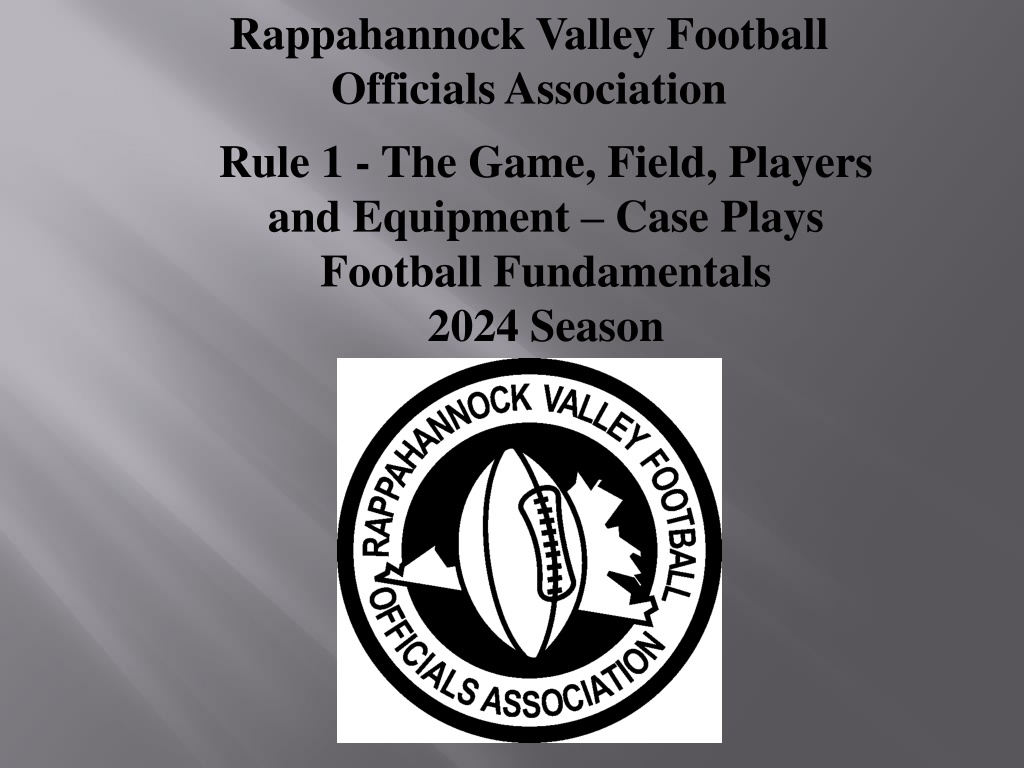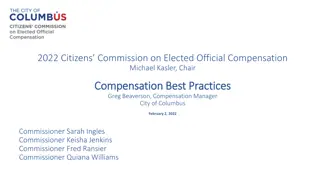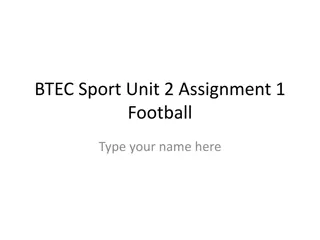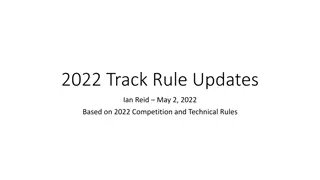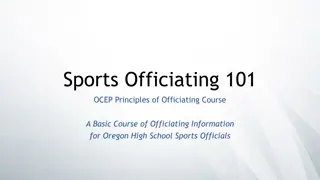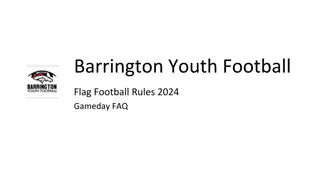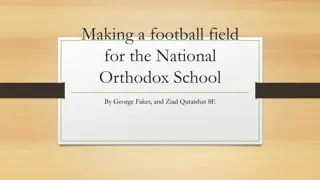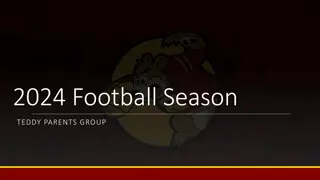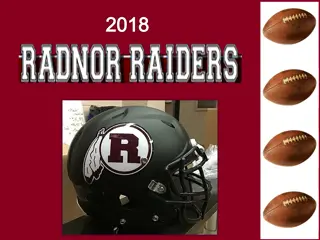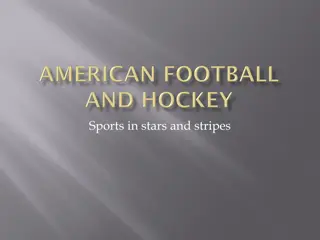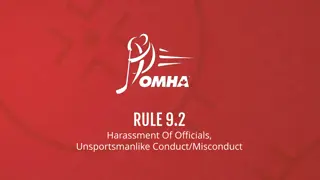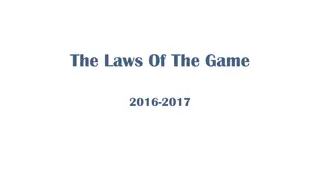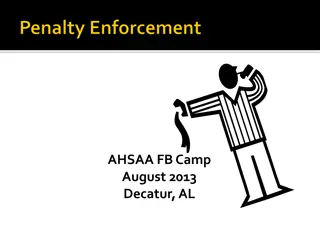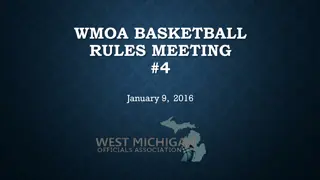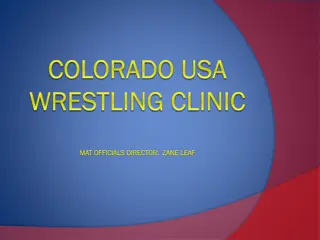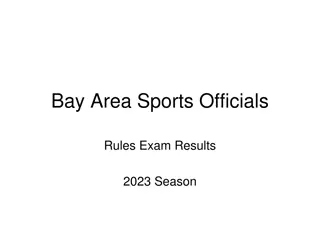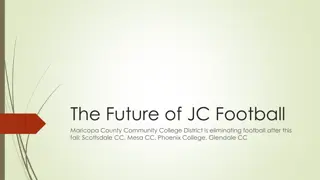Rappahannock Valley Football Officials Association Rules Overview
The Rappahannock Valley Football Officials Association provides detailed rules and guidelines for football games, covering information on players, equipment, game officials' authority, and choice of ball. The authority of game officials, player requirements, and conduct regulations are explained to ensure fair play and sportsmanship throughout the game. These rules aim to maintain the integrity of high school football competitions in the 2024 season.
Download Presentation

Please find below an Image/Link to download the presentation.
The content on the website is provided AS IS for your information and personal use only. It may not be sold, licensed, or shared on other websites without obtaining consent from the author. Download presentation by click this link. If you encounter any issues during the download, it is possible that the publisher has removed the file from their server.
E N D
Presentation Transcript
Rappahannock Valley Football Officials Association Rule 1 - The Game, Field, Players and Equipment Case Plays Football Fundamentals 2024 Season
Rule 1-1 How many players must a team have to start a game? Eleven players must be able to start the game. It may continue with fewer as long as formation rules are not violated. When do the officials assume authority for the game? Thirty minutes prior to scheduled game time. How long does an official s authority last? The game official authority extends through the referees declaration of the end of the fourth period or overtime.
RULE 1 GAME OFFICIALS AUTHORITY 1.1.6 SITUATION: Prior to the game, both teams wait for the other team to go on the field first. RULING: The referee shall direct the home- team coach to have his team enter first. The referee has authority to rule on any situation not specifically covered in the rules.
Rule 1 GAME OFFICIALS AUTHORITY 1.1.7 : With 35:00 on the countdown clock, individuals on the field for pregame warm-up engage in unsportsmanlike behavior. The state association rule is that game officials: a) assume authority 30 minutes before the game: b) assume authority 45 minutes before the game or c) authority prior to the game is not addressed in state associations. RULING: In a) and c) there is no foul as this is a game administration issue and not one under authority of the game officials. In b) the unsportsmanlike conduct fouls would be assessed prior to the kickoff and should be explained thoroughly by the referee prior to the coin toss options being given.
Rule 1 GAME OFFICIALS AUTHORITY 1.1.8 SITUATION C: Immediately following the contest, the coach of Team A curses the game officials as they are leaving the field and prior to their return to their dressing room. This occurs: (a) before; or (b) after the referee has declared the end of the contest with the proper signal. RULING: In either situation, this is an unsportsmanlike act. Fouls such as this foul will not involve a distance penalty as the game has ended for the purpose of on-field play, but unsportsmanlike acts such as this remain under the authority of the game officials for the purpose of filing necessary reports regarding unsportsmanlike acts. Incidents such as this shall be reported to the home school state association in accordance with adopted procedures.
Rule 1 Choice of Ball In high school football, what materials can a football be made of? Tan-colored cover consisting of either pebbled-grain, cowhide or approved composition (leather or rubber) without corrugations other than those formed by the natural seam grooves and the laces on one of the grooves. When can a team request a new ball? Each team may use any referee-approved ball of its choice to free-kick or start a new series of downs. If a touchdown occurs following a change of possession and the scoring team did not put the ball in play, any referee-approved ball may be used for the try.
Rule 1 Choice of Ball 1.3.2 SITUATION D: The referee has examined and verified the legality of a number of balls provided by each team prior to the game. However, during the course of the game, the weather conditions change dramatically and the teams wish to have additional balls approved for use. RULING: This is permissible and is within the intent of the rule.
Rule 1 Line to Gain Crew 1.3.5 SITUATION: The "chain crew" who has been "doing this for 25 years," wants to have the line-to-gain equipment on the sideline even though there is plenty of room to have the equipment 2 yards off the sideline on the restraining line. RULING: All "chain crews" must comply with Rule 1-3-5b. If the "chain crew" is insistent, the game officials should contact game administration to address the situation.
Rule 1 Captains Decision 1.4.1 SITUATION: Team A's captain requests a time-out prior to: (a) making a penalty decision; or (b) deciding whether A will snap or free kick following a fair catch; or (c) designating where the ball is to be spotted on the 3-yard line for a try. RULING: Not allowed in (a), but permissible in (b) and (c). COMMENT: In the case of considering an awarded fair catch, the captain would have to make his decision on the penalty prior to requesting a time-out. After accepting the penalty via an awarded catch, a time-out can be taken to consider whether to snap or free kick. (2-32-5, 6-5-4, 10-1-1)
Rule 1 Player Numbering 1.4.3 SITUATION: After the ball has been marked ready for play, but prior to the snap, it is discovered: (a) A1 and A2 are both wearing number 81, or (b) B2 is wearing 00. (c) B1 is wearing 0. RULING: In (a), it will become a foul at the snap for illegal numbering. In (b), it is a foul before the snap for illegal numbering and B2 will not be permitted to - participate with that number, because 00 is not a legal number. In (c), there is no foul since as of 2022 the number 0 was legal. If the illegal numbering is discovered during the down, it is a foul which occurred at the snap. Also, any number preceded by a zero such as 09, is illegal. [1-5- 1c(1), 7-2-5d]
Rule 1 Player Equipment 1.5.1 SITUATION A: B10 has (a) a two-attachment points chin strap or (b) a four- attachment points chin strap and the umpire notices that not all attachment points are secured. RULING: This is a foul in both situations. All available attachment points must be secured and all helmets must be secured with a four- attachment points system. [1-5-1a(2), 1-5-6, 3-6- 2d, 9-8-1h]. In (a) the head coach is charged with a non-player unsportsmanlike foul, 15 yards, for illegal equipment. In(b) , the equipment is legal so player is sent off for one play, no foul assessed against the head coach.
Rule 1 Player Equipment 1.5.1 SITUATION B: Team A s players are wearing jerseys: (a) just covering the shoulder pads, and their midriffs are exposed; or (b) that extend below the top of their pants, but some players have them tucked in, while others have them outside their pants; or (c) that are to the top of the pants, but have tucked them up under the bottom of their shoulder pads; or (d) with an undershirt that extends below the top of the waistline of the pants and is not tucked in. RULING: The jerseys in (a) are not legal. In (b) and (d), the jerseys (and undershirts) of all players will have to be tucked inside the pants upon discovery and tucking the jerseys may not delay the ready-for-play signal. The jerseys in (c) are legal but being worn improperly. Players must be sent off for at least one play and until the violation is corrected. [1-5-1b(1), 1-5-6, 3-5-2b, 3-6-2d, 9-8- 1h]
Rule 1 Player Equipment 1.5.1 SITUATION G: The umpire notices that a player does not have protrusions indicating that hip pads and tailbone protector are being worn. Upon investigating, it is found that (a) the player is not wearing any padding or (b) the player is wearing a manufactured girdle with closed cell, "bubble type" protective padding that conforms and covers the hips and tailbone. RULING: (a) Hip pads and tailbone protector are required equipment. If required equipment is noted to be missing between downs, the player must be removed from the game. If the game officials are unable to detect the missing equipment and the player participates without the required equipment, a foul is to be called. The head coach may be penalized 15 yards for a non-player unsportsmanlike conduct foul for player not wearing required equipment. In (b), there is no padding criteria listed for hip pads and tailbone protector and, therefore, the pads are legal. [1-5-1d(1), 1-5-5, 1-5-6, 3-6- 2d, 9-8-1h]
Player equipment If both teams take the field wearing non-white jerseys what are the options for the referee? 1.5.1-If the visitors do not have the white jerseys, the referee may require the home team to change to white and report this to VHSL If worn, what are the requirements for gloves? 1-5-2b-Must have the NOCSAE stamp unless made of plain cloth and do not enhance ball contact. Can a player wear sunglasses while playing? During pregame, you notice players wearing bicep bands, bands on their calves, midriffs exposed, and pants not covering the knees. As an official what do you do?
Rule 1 Legal and Illegal Equipment 1.5.3 SITUATION B: A1 is wearing: (a) a biceps pad; or (b) a partially exposed hip pad; or (c) an ankle support. In all three cases a hard plastic surface on the outside of the pad/support is not covered, but all the edges are rounded and there are no cutting or abrasive surfaces. RULING: The items described in (a), (b) and (c) are legal. The exposed plastic does not require a covering on these specific items of equipment. However, if any of the plastic surface is cracked or has a cutting edge it would not be legal. If the biceps pad is connected to the shoulder pad, it must be fully covered by the jersey.
Rule 1 Legal and Illegal Equipment 1.5.3 SITUATION C: Prior to the game, the coach of B requests the umpire to examine a cast/splint on the forearm of a player. The protective item has hard material, but is padded with at least -inch thick, closed-cell, slow-recovery foam padding. The coach: (a) provides; or (b) does not provide to the umpire prior to the start of the game, a written authorization from a licensed medical physician directing the use of the cast/splint as necessary to protect an injury. RULING: In (a) and (b), the cast/splint may be worn during the game. Written authorization is no longer required but the umpire must ensure the cast/split is properly padded. (1-5-3b(1))
STATE ASSOCIATION ADOPTIONS 1-7 Each state association may, in keeping with applicable laws, authorize exceptions to NFHS playing rules to provide reasonable accommodations to individual participants with disabilities and/or special needs, as well as those individuals with unique and extenuating circumstances. The accommodations should not fundamentally alter the sport, heighten risk to the athlete/others or place opponents at a disadvantage.
Table 1-7 - Table of State Association Adoptions 1. Determine the number of game officials to be used in the game.(1-1-4 NOTE) 2. Determine the time for game officials to assume authority if greater than 30 minutes (1-1-7) 3. Approve an extension of the team box if the same for both teams. (1-2-3g NOTE 3) 4. Mandate the use of a specific ball for postseason or playoff competition. (1-3-2 NOTE) 5. Authorize the use of supplementary equipment to aid in game administration. (1-3-7) 6. Authorize the use of instant replay during state postseason contests. (1-3-7 NOTE) 7. Authorize the wearing of a commemorative/ memorial patch. (1-5-1b, 2-3 NOTE) 8. Authorize the use of a drum for rhythmic cadence for deaf or partially deaf teams. (1-6-1NOTE)
9. Authorize exceptions to NFHS playing rules to provide reasonable accommodations to individual participants with disabilities or special needs. (1-7) 10. Establish a procedure to resolve games tied following the fourth period. (3-1-1 NOTE) 11. Establish a point differential to terminate games or to use a running game clock when the point differential is reached. (3-1-2) 12. Establish rules regarding continuation of interrupted games. (3-1-4) 13. Determine the length of halftime intermission. (3-1-6) 14. Determine when the coin toss is to be held. (3-2-1) 15. Authorize the use of TV/radio time-out (3-5-7k) 16. Designate the 11-player field dimensions as official for nine-, eight- or six- player competition. (Football Field Diagrams) 17. Determine the dimensions of the field for nine-, eight- and six-player competition. (Football Field Diagrams)
